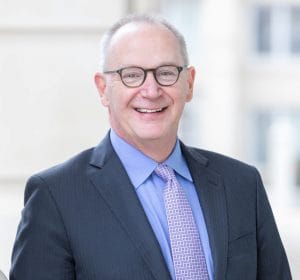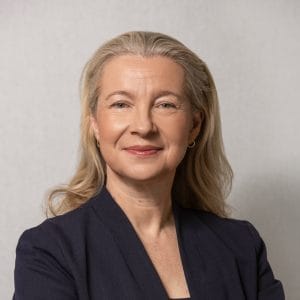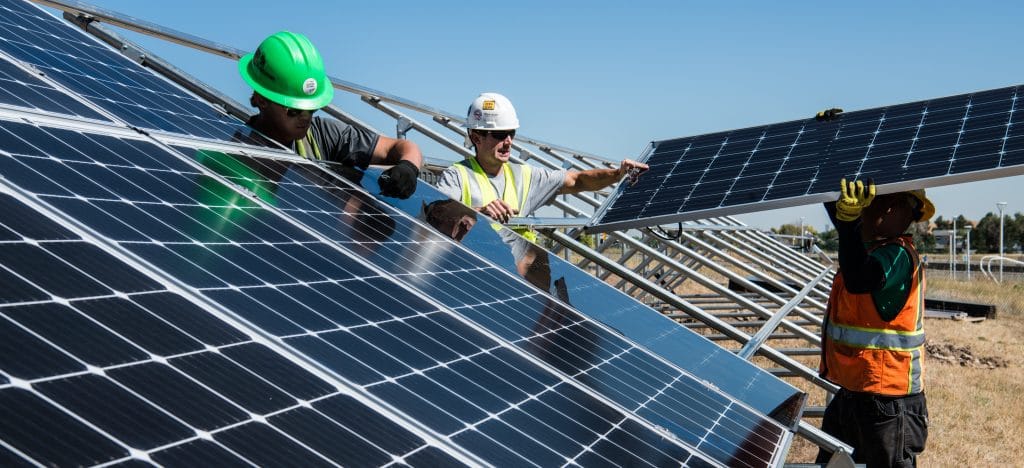A Conversation with Hannon Armstrong* CEO Jeffrey Eckel
 Hannon Armstrong Sustainable Infrastructure Capital (Hannon Armstrong), a holding in the Green Century Balanced Fund, is the first publicly-traded company in the U.S. “solely dedicated to investments that reduce carbon emissions or increase resilience to climate change.”
Hannon Armstrong Sustainable Infrastructure Capital (Hannon Armstrong), a holding in the Green Century Balanced Fund, is the first publicly-traded company in the U.S. “solely dedicated to investments that reduce carbon emissions or increase resilience to climate change.”
Hannon Armstrong invests more than $1 billion per year in environmentally-responsible projects and had more than $6 billion in managed assets as of December 31, 2019.
To learn more about Hannon Armstrong and its commitment to sustainability, Green Century President Leslie Samuelrich recently spoke with Hannon Armstrong CEO Jeffrey W. Eckel. Here is their exchange.
Green Century President Leslie Samuelrich: Why does Hannon Armstrong only invest in efficiency, renewable energy, and other sustainable infrastructure markets?

Jeffrey W. Eckel, CEO, Hannon Armstrong
Our investment thesis is as simple as it is compelling. In a world increasingly defined by climate change impacts, we believe we will earn superior risk-adjusted returns by investing on the right side of the climate change line.
In fact, there have been so many recent positive developments in the burgeoning climate solutions market. As energy efficiency, wind, solar, and storage technologies continue to get cheaper, their deployment is spreading rapidly. Our client base in this sector is expanding, with established players growing and new entrants, from large multinationals to venture-backed digital companies, all investing heavily to drive our decarbonized electric power future.
Driven by younger generations who will have to live with climate change and increasingly by owners of capital, such as pension funds, the reallocation of capital based on a more realistic assessment of climate risk and opportunity is starting. I believe this shift will accelerate much faster than many appreciate.
Samuelrich: Why aren’t more companies following suit?
While there are other public and private companies that develop, own, and/or operate renewable energy generation assets, no other single company has put together an investment firm quite like ours that invests in both the supply and demand sides of our energy ecosystem.
With a total annual addressable market of over $100 billion in the U.S. alone, we sincerely welcome others into this space. It will take the combined efforts of the best and brightest of current and future generations to meaningfully tackle our climate crisis.

Leslie Samuelrich, President, Green Century Capital Management
Samuelrich: The Hannon Armstrong investment thesis is: We will earn better risk-adjusted returns by investing on the right side of the climate change line. Why do you believe that?
Quite simply, in an increasingly resource constrained world, our investments in climate-positive technologies save customers money (as well as contribute to a brighter climate future), so their willingness to pay and their demand for our sorts of projects is strong and growing.
And the results are in the pudding as they say. In 2019, we invested a record $1.3 billion, delivering a 65% increase in earnings per share and a 22% increase in Core Net Investment Income, year over year. In fact, to date, we have over $6 billion of climate-positive assets under management, and since we went public in 2013, our total average annual shareholder return is nearly double that of the S&P 500.
Samuelrich: In your most recent letter to stakeholders, you wrote that “banks and investors must ask themselves, ‘Does this investment accelerate or slow climate change?’ We couldn’t agree more and have been actively pushing the industry to truly make sustainability and climate risks central to its investing strategy. Why have some banks been so slow to act with the urgency needed?
Unfortunately, what the banks and investment firms don’t realize is that there is a fundamental change occurring in the economy. BlackRock’s CEO Larry Fink made waves recently when he said, “we are on the edge of a fundamental reshaping of finance” because of climate change. But the real question is how will this transformation toward sustainable finance actually unfold?
This simple but fundamental question – “Does this investment accelerate or slow climate change?” – is one most Wall Street banks and asset managers are inherently reluctant to ask because it represents a line that challenges their entrenched business models. For example, the CEO of a major investment bank remarked that they would not “draw a line” on climate change and would continue to raise money for fossil fuel companies.
Yet business as usual for fossil fuel investing will increase greenhouse gas emissions for decades, something we do not have time for. At Hannon Armstrong, we take a different approach. Every investment improves our climate future. We invest on the right side of the climate change line every single time. It’s what we do. It’s all we do.
Samuelrich: And our investors appreciate it.
You were named the Responsible CEO of the Year for ESG Leadership. Can you explain how you evaluate and use ESG performance?
There has been much recent debate over the usefulness of ESG reporting given the range of standards and their inconsistent application. I believe ESG reporting should be standardized and, just as importantly, integrated into annual financial reporting.
ESG reporting matters because its elements are material to financial results. At Hannon Armstrong, an emphasis on a durable social fabric, including a diverse, engaged, and fairly compensated staff, is a material factor in our financial success. Similarly, our top-notch corporate governance practices assure our shareholders that our team will stay on track and deliver results. And of course, the environmental impact of the firm is embedded in our DNA with CarbonCount®. We are proud to remain a leader in ESG performance and reporting.
Most recently on the ESG front:
• We offered 100% match of employee contributions made to qualified non-profit organizations that focus on organizations confronting racial and economic injustice, voter suppression, and other civil rights violations;
• We donated $150k to support COVID-19 relief efforts by three Maryland charities focusing on combating homelessness, hunger, and domestic violence;
• We are also title sponsor for the Chesapeake Bay Foundation’s Walk the Watershed fundraiser, for which we’ve raised nearly $32k and engaged 25 employees who have walked more than 500 miles to date;
• We issued another $400 million in green bonds;
• We signed the largest ever UN-backed, CEO-led climate advocacy agreement, and we joined Ceres and more 300 companies in LEAD on Climate 2020 movement.
Samuelrich: Impressive.
When Hannon Armstrong is evaluating potential infrastructure investments, how important is sustainability?
The very first investment screen our investment committee looks at is whether a proposed project reduces carbon emissions and/or provides water or other resource conservation benefits. To this end, we developed CarbonCount®, transparent, comparable, and accountable proprietary tool for evaluating investments in U.S. based renewable energy and energy efficiency projects to determine the efficiency by which our invested capital reduces carbon emissions. When potential investment opportunities fail to produce a positive and meaningful CarbonCount® or other tangible environmental benefits, we will not invest.
Samuelrich: Is there an investment that you’re particularly proud of?
Last quarter, we invested $115 million in preferred equity into the Hawkeye Energy, a landmark public-private partnership between ENGIE and the University of Iowa. Hawkeye Energy was awarded a $1 billion, 50-year utility management concession contract, and the investment reached financial close on March 10th. Hawkeye Energy will support the University ’s energy, water, and sustainability objectives for two campuses spanning 1,700 acres, including meeting its zero-carbon energy transition objectives and becoming coal-free in campus energy production on or before 2025.
 Innovative in both scope and ambition, it serves as a campus utility system model for major U.S. universities and research hospitals that look to achieve their cost and sustainability objectives. The investment’s financial profile is strong, with an attractive, 50-year, risk-adjusted return from contracted cash flows from a high investment grade counterparty. This expansion into the higher education P3 market also grows and diversifies our pipeline and strengthens the portfolio, while fully aligning with our climate-positive ESG objectives.
Innovative in both scope and ambition, it serves as a campus utility system model for major U.S. universities and research hospitals that look to achieve their cost and sustainability objectives. The investment’s financial profile is strong, with an attractive, 50-year, risk-adjusted return from contracted cash flows from a high investment grade counterparty. This expansion into the higher education P3 market also grows and diversifies our pipeline and strengthens the portfolio, while fully aligning with our climate-positive ESG objectives.
Samuelrich: Oh, that’s great.
How important is sustainable investing to the effort to combat the climate crisis?
All the climate scientists and models tell us we are running out of time to prevent catastrophic climate change. Without the swift deployment of trillions upon trillions of dollars of investment to fully decarbonize our growing global economy, we won’t get there in time. So, I think most agree that the mobilization and deployment of this climate-positive capital is of the upmost importance.
Samuelrich: We couldn’t agree more and are grateful that companies like Hannon Armstrong are taking action. Thank you for your time and environmental commitment.
Learn more about sustainable investing at Green Century.
About Green Century Management
*As of March 31, 2020, Hannon Armstrong Sustainable Infrastructure Capital comprised 0.26%, 0.00%, and 0.00% of the Green Century Balanced Fund, the Green Century Equity Fund, and the Green Century MSCI International Index Fund, respectively. References to specific securities, which will change due to ongoing management of the Funds, should not be construed as a recommendation by the Funds, their administrator, or the distributor.
You should carefully consider the Funds’ investment objectives, risks, charges and expenses before investing. To obtain a Prospectus that contains this and other information about the Funds, please click here for more information, email info@greencentury.com or call 1-800-934-7336. Please read the Prospectus carefully before investing.
Stocks will fluctuate in response to factors that may affect a single company, industry, sector, country, region or the market as a whole and may perform worse than the market. Foreign securities are subject to additional risks such as currency fluctuations, regional economic or political conditions, differences in accounting methods, and other unique risks compared to investing in securities of U.S. issuers. Bonds are subject to risks including interest rate, credit, and inflation. A sustainable investment strategy which incorporates environmental, social and governance criteria may result in lower or higher returns than an investment strategy that does not include such criteria.
This information has been prepared from sources believed to be reliable. The views expressed are as of the date of this writing and are those of the Advisor to the Funds.
The Green Century Funds are distributed by UMB Distribution Services, LLC. 235 W Galena Street, Milwaukee, WI 53212. 6/20


